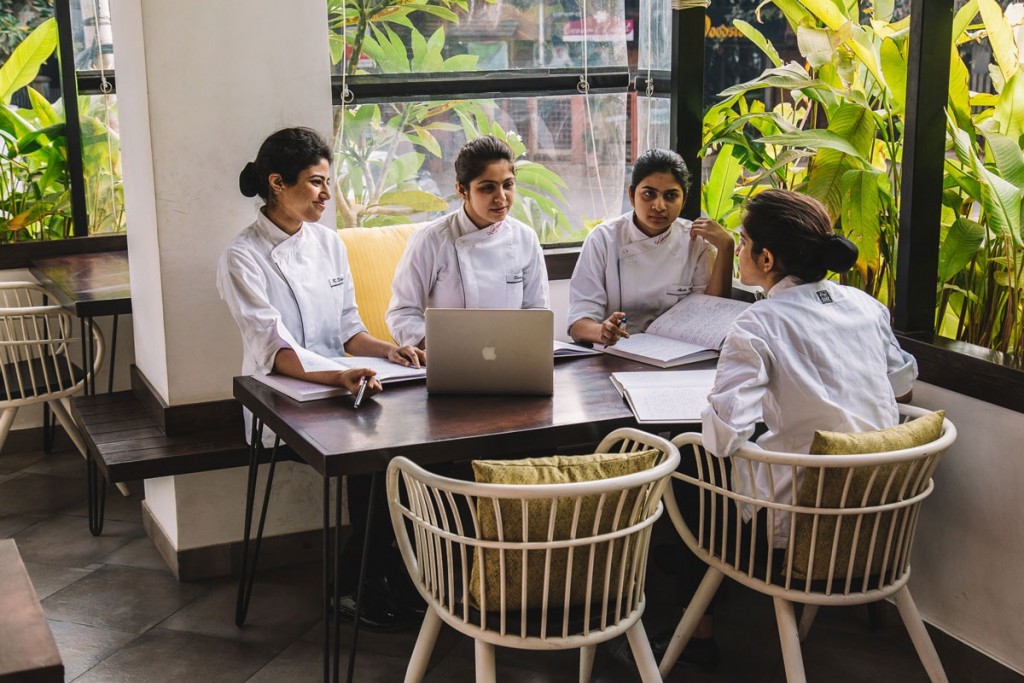To a beginner, the world of baking can seem intimidating. And to the seasoned baker, it can sometimes pose frustrating challenges. It’s during times like these that a thorough knowledge of the basics goes a long way in ensuring your product is perfect.
Coming to your aid, is our very own Chef Avin, who shares his expertise on the most common cooking mishaps in a Pâtisserie, and gives you simple tips to ensure you create the perfect product.
Starting off the classes is a crash course on Cake Faults.
The Ideal Cake
Cakes are arguably the most popular food product to bake, and are also extremely varied. So, you can’t really term any cake as the ideal one. The types range from sponge cakes, which are judged based on their lightness, to other kinds that are measured in terms of complexity.
A common misconception a lot of people have today is assuming sponges are complete cakes by themselves. In my opinion, they are only a base for a finished cake. A lot more goes into making a complete cake.
Similarly, most faults that occur in cake baking are either due to inadequate information or lack of experience. My experience in the field has taught me that some faults are more common than others.
Fault # 1
Batter curdling

Photo courtesy: http://www.wildyeastblog.com/wp-content/uploads/2008/
This is a problem commonly faced by beginners. Normally, this occurs because some sort of change takes place while mixing the ingredients. This change is caused when the ingredients are either too cold or too warm. The result is curdling.
Possible reasons
There are three possible reasons for this. The first being, not all the ingredients are of the same temperature. There are some ingredients that are cold, while some are warm.
The second reason could be that the fat content in the butter is on the higher side. The third possibility is that the fat is not creamed properly. If the butter and sugar are inadequately creamed and any liquid is added, the batter curdles.
Chef’s Tip
When I am creaming, I add a portion of flour into the mixture. The flour takes out all the moisture and water content, and this ensures curdling does not take place. Another solution is to simply ensure that all ingredients are of the same temperature. Sometimes, people take the eggs straight out of the refrigerator and add it to the batter. They should allow it to thaw, reach room temperature and only then use it.
And in the initial stages, stick to using the correct ingredients. Don’t get carried away with using fancy ones until you’ve perfected the process.
Fault # 2
Low volume
In India, we use one flour for making everything. If you use the same flour across products, for example bread flour for cake baking, you’re likely to face this problem.
Possible reasons
Bread flour has a higher amount of gluten, and is too strong for cake baking. It is better to use a weaker flour that is more suited for cakes.
If it’s not the flour, it could be the baking powder or soda, commonly referred to as leavening. Taken straight from the fridge, the leavening agent is still cold, and this also causes low volume.
The third possible reason for this fault could be under whipping of the eggs. And if it’s none of those, it could also mean that the oven is too hot—normally cakes are baked at 160-190 degrees. Any higher than that, the protein coagulates too fast and the resulting cake is low on volume.
Chef’s Tip
Always use fresh ingredients, that are at room temperature. I can’t stress the importance of this enough.
Further, eggs should be whipped in a manner that allows air to get incorporated into the mixture. Inexperienced bakers sometimes fold it too much, and as a result the mixture loses air. Always use the correct mixing method.
Additionally, make sure the oven is at the right temperature before baking.
Fault # 3
Cracked Top/ Crust Burst

Photo courtesy: http://indianexpress.com/article/lifestyle/food-wine
This usually happens right at the end of the baking process, and sometimes it simply means that the cake is completely cooked. So it’s not always a bad thing. However, it does pose a problem in terms of finished appearance.
Possible Reasons
The main reason this happens is too much flour being added to the mix. Baking is a science and every recipe is standardised. It needs to be followed or modified based on the kind of cake being made.
Sometimes, the liquid content or moisture in the mixture is too less, and that’s why it cracks.
Other times, the oven ends up being non-idicative of actual temperatures. That is to say, it might be showing a particular temperature in the readings, but the inside could be a lot hotter.
Chef’s Tip
Experiment! Keep trying things out and learn to adjust the formula. Also, weigh your ingredients carefully. With practice, you’ll get a much better idea of how to balance your ingredients. Another key trick is to know your equipment well. Keep practicing until you gain a good idea of the perfect temperature for your oven.
Fault # 4
Sinking Cake

Photo courtesy: http://images.wisegeek.com/fallen-chocolate-cake.jpg
This is perhaps the most common cake fault, and happens right at the end of the baking process. Your cake is done and as you’re taking it out of the oven, it just sinks. This is called the V Fault, and happens because the internal structure of the cake is weak.
Possible Reasons
The V Fault usually occurs when the sugar level is too high or the fat in the butter is too much for the flour to hold. The gluten in the flour is unable to hold up, and as a result, the cake sinks.
Chef’s Tip
Adjust the formula. Make sure you’re putting the right amount of each ingredient in.
This might also happen when you take the cake out too early. So before you do, take a knife or a toothpick and stick it into the cake. If the cake is properly cooked, it should come out clean. If the knife/toothpick come out coated, you need to allow it to bake longer. The Bundt Thermometer is used for this purpose, but knives and toothpicks are a more commonly available option.
Fault # 5
Very Dense Cake
This refers to when the resulting cake ends up being extremely thick. And multiple reasons can cause this.
Possible Reasons
The first one could be too much of baking powder or soda in the mix, which means the leavening is on the higher side. Additionally, it could also be a high fat or liquid content. Both in excess result in dense cakes.
The third reason, and the most common, is that the oven is not heated to the right temperature for baking and is too cool.
The fourth reason, usually in the case of inexperienced bakers, could be improper mixing. In our eagerness, we sometimes overdo the mixing and remove all the air from the mixture, resulting in this denseness.
Chef’s Tip
This tip keeps recurring, and comes with practice—adjust the formula. Apart from that, while creaming the fat or the eggs, make sure to fold them properly, without overdoing or under-doing it. This of course, comes with experience, so keep at it!
Fault # 6
Poor flavour
Sometimes, even when you’ve done everything you need to do, and the cake turns out great, the final taste is anything but perfect.
Possible Reasons
The most obvious—the ingredients being used are bad.
In other cases, the baker sometimes uses a mix of ingredients to create a melange of flavours, but ends up using flavours that are incompatible with each other. Like while orange goes great with chocolate, adding the same flavour to white chocolate can cause a mess.
Another not-so-common, but possible reason, could be an unclean baking pan.
Chef’s Tip
Make sure you use good quality ingredients. There is no substitute for this. Also, when in the initial stages of baking, don’t get too carried away with trying exotic flavours and combinations. Get the basics in place before experimenting.
In the case of unclean pans, sometimes leftover oils from earlier greasing goes rancid and ends up affecting the flavour of the freshly baked cake. Ensure that all equipment you use is cleaned and stored hygienically.
Fault # 7
Uneven Shape

Photo courtesy: http://www.vietworldkitchen.com/.a/
The uneven end result, also known as the S Fault, is another common occurrence in cake baking.
Possible reasons
Here, there are four possible culprits—either the butter incorporated does not have an even distribution of fat, the spreading of the batter in the pan is uneven, the rack inside the oven is not even or the temperature inside is uneven. With the oven, sometimes the thermostat is faulty, and one side can be a different temperature than the other.
Chef’s Tip
Incorporate the fat correctly into your recipe. By now you can see how important getting the formula right is. Most faults are caused by that alone. Also, spread the batter evenly and make sure the oven temperature is adjusted correctly.
Fault # 8
Fruit sinking
You sprinkle the cake batter with a whole host of fruits, to make the cake more exciting, and they end up sinking to the bottom.
Possible Reasons
Most often, the fruits being used are denser than the flour of the cake, and they end up sinking to the bottom. It really depends on the kind of fruits you use—cashwenuts are a lot heavier while raisins are not. So you need to take that call.
Chef’s Tip
What I do in this case, is coat the fruits with flour before adding them. While not a 100% fail-proof method, it works most of the times.
Fault # 9
Peaked tops

Photo courtesy: http://mosquitosblood.blogspot.in
The cake looks fine, the volume is right, but the top ends up rising a bit too much, giving a disproportionate appearance.
Possible Reasons
Too much of leavening and the bottom part of the cake being too heavy.
Chef’s Tip
Ensure that the amount of baking soda or powder being used is measured with precision.
Fault # 10
Wet streak at the base of the cake

Photo courtesy: https://ontotheplate.files.wordpress.com/2013/
The entire cake ends up being cooked perfectly, and has a great shape, but you find that the bottom of the cake is still wet and uncooked.
Possible Reasons
This is an indicator of the fact that the centre of the cake is not cooked. This is usually because the cake tin is filled with batter greater in quantity than its holding capacity. If you add more than what you’re supposed to, the cake definitely won’t cook properly.
Chef’s Tip
I have a nifty little formula for this. I weigh the cake tin (in grams), and then multiply that number by 4 or 4.5 grams. I then add only that quantity of batter into vessel and keep it for baking. This way I ensure that the oven temperature reaches all parts of the cake evenly.
These are some of Chef Avin’s tips, and we hope they help you with your cake baking pursuits. Watch this space for more such tips and tricks, so that your baking process wields gorgeous results.




